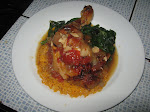Mise en Place
'A French term that literally means, "setting in place." It's used in cooking to describe all the prep and gathering of ingredients before starting the actual cooking process."
I took this definition off the internet and there are several definitions available there if one wishes to do the search.
Mise en place is a French phrase that gets bandied around quite a bit in cooking circles. It has become a newly hip phrase on TV cooking shows and I often hear it used by people attempting to show their kitchen savvy, if not their savoir faire. Essentially it means to have everything you need ready before you start. To cook, to bake, to clean, to write, to do almost anything. I have also seen it defined as "all things in place".
It seems like a simple enough concept. Why wouldn't you have everything ready before you start? Why would you subject yourself to the stress, distraction and lack of focus that having to stop and start, stop and start repeatedly create during your cooking process? Shouldn't one have a list? Shouldn't one be able to create "mise en place" simply from a recipe? Shouldn't this be easy? And what kind of a kitchen geek do I take you for, anyway?
Oddly enough, in my coast to coast travels, and in the many, many restaurants in which I have manned the stoves (I won't bore you with how many; but it's somewhere over 55) it has never ceased to astonish me how many professional cooks don't understand "mise en place". I have seen scores of fresh culinary grads struggling through what may be one of the most horrible parts of a kitchen job, prepping on the fly while orders are already coming in. For some cooks simply being "in the weeds" with too many orders is hellish, but to me, the worst, the most horrible nightmare come true, is trying to make sauces and set up your station while orders are coming in that require ingredients you have not yet made. It gives me shivers and the willies just thinking about it now.
When I worked at the Harvest in Cambridge, MA, our kitchen motto was "Mise en place is God" and while it may be a bit extreme for someone cooking in their home, it isn't far from the truth for any cook in any kitchen. Mise en place is certainly about ingredients and having things at your fingertips. It is about having your pots and pans at the ready; the pasta water boiling; your cutting board firmly anchored and your knives steeled. It is about all those little bins of herbs, your special oils, your pre-made sauces and your portioned fish and meat. But mise en place is also a state of mind and if you don't mind my going all zen on you, a state of being; a state of being ready and knowing it.
For a restaurant cook, this means knowing and understanding your movements from the time the first order comes in. The ingredients most used are closest to where they will be used. The sauces or stocks are lined up so the ladles won't get too hot to grab, but are still close enough to the fire and the pans. The meat or fish are kept cool, but close enough to the grill to be able to oil and season before going onto the heat. Fresh herbs, chopped vegetable garnishes, garlic and other ingredients for assembling pan sauces are within an arms reach and protected so that liquids, oils and flying kitchen debris will stay out of them for the time they are out. And lastly, there is the confidence that twenty, or ten, or even two minutes before the doors open, that these things are ready; they are right and perhaps most importantly, there is enough of each of them.
So yes, professional cooks need all those things, set up just so, because in a professional kitchen we all live and (hopefully not) die several times a night in restaurant that "turns 'em and burns 'em". But this kind of preparation and this kind of awareness are just as useful and as important if one is cooking at home. A simple understanding of the steps you are about to take makes dinner for guests, family or even yourself so much less stressful. I certainly don't know that much about you, but even when I cook for myself, or perhaps particularly when I cook for myself, I like things to proceed smoothly and easily. I may be a bit of an adrenaline junkie, but not when it involves frustration, stress and self abasement. "Aaargh, you moron, you forgot to chop the garlic, or even peel it!".
So get yourself a plan. Think about what you really want to do and how you want it to proceed. And this by no means is an effort to halt the creative process or to squelch your spontaneity. But make it easy on yourself; think about the pots you need, the ingredients you may or perhaps, may not, need. Consider your timing, your distances from table to stove and get yourself focused. Food is art and art is pain, but Picasso knew where all his colors were and how he wanted to apply them. Miles Davis may have improvised, but he knew exactly where he wanted to go. You in your kitchen; professional or home, need to have your own vision of what you wish to do and how to go about it. And remember, "Mise en place is God".



























































